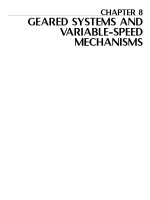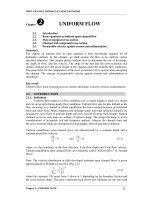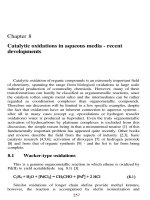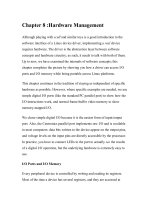CHAPTER 8: MOSFETS.OBJECTIVES docx
Bạn đang xem bản rút gọn của tài liệu. Xem và tải ngay bản đầy đủ của tài liệu tại đây (330.53 KB, 20 trang )
CHAPTER 8
MOSFETS
OBJECTIVES
Describe and Analyze:
• Theory of MOSFETS
• MOSFET Amplifiers
• E-MOSFET Switches
• Troubleshooting
Introduction
• MOSFET stand for Metal-Oxide-Semiconductor (or
Metal-Oxide-Silicon) Field-Effect-Transistor
• Like JFETs, MOSFETs come in N-channel and
P-Channel types
• Unlike JFETs, MOSFETs can be manufactured as
enhancement-mode (E-MOSFETs) as well as
depletion-mode (D-MOSFETs).
• There is no PN junction. The metal gate of a
MOSFET is isolated from the silicon channel by a
thin layer of silicon oxide
(Si O2, commonly known as glass)
• MOSFETs can be damaged by static electricity
D-MOSFETs
Similar to a JFET, but Zin of device is almost infinite
D-MOSFETs
Unlike JFETs, D-MOSFETS can work with zero bias
D-MOSFETs
The same bias circuits used with JFETs can be
used with E-MOSFETs. In addition, a class-A
MOSFET amplifier can work with VGS = 0.
D-MOSFET Amplifiers
The equations for Zin, Zout and Av developed for JFET
amplifiers can be used with D-MOSFET amplifiers.
Like JFETs, D-MOSFETs are used in the front ends of
radio receivers because of their inherently low
internal noise.
D-MOSFET AGC Amplifiers
Since gm depends on the Q-point, MOSFETs are used
for Automatic Gain Control in radio receivers
D-MOSFET Mixers
Unlike JFETs, D-MOSFETs can be built with two gates.
That allows them to be used as radio “mixers” to
multiply one signal by another.
E-MOSFETs
In an enhancement-mode MOSFET, the drain is
isolated from the source because the substrate is
doped opposite the source and drain. Voltage applied
to the gate causes the substrate under the gate to “flip
polarity”. P-material becomes N-material as charge
carriers are attracted into the region by the gate.
E-MOSFETs
The key parameter for an E-MOSFET is the threshold
voltage (VGS(TH)) required to turn it on
E-MOSFET Switches
The most common use for an E-MOSFET is switching
E-MOSFET Switches
The IRF510 E-MOSFET is a typical power switch. Its
key specifications are:
• VGS(TH) = 4 Volts max
• RDS(on) = 0.54 Ohms max
• ID(MAX) = 5.6 Amps
• IDSS = 25 A (remember: it’s off)
• BVDSS = VDS(MAX) = 100 Volts
• PD(MAX) = 43 Watts
• Rise-time tR = 63 ns
E-MOSFET Switches
• The most common application of E-MOSFETs like
the IRF510 is to drive the transformer in switch-mode
power supplies and DC to DC converters.
E-MOSFET Switches
E-MOSFETs can also switch analog signals
E-MOSFET Switches
Choppers convert DC or low-frequency AC into
higher-frequency AC suitable for processing
Digital MOSFET Switch
Because of their small size, low power, and speed, digital
ICs such as microprocessors use MOSFET switches
E-MOSFET Amplifiers
When biased on, E-MOSFETs can have a high gm
CMOS
• CMOS stands for:
Complementary Metal-Oxide-Semiconductor.
• They combine N-channel and P-channel MOSFETs.
• They are primarily used in low-power digital ICs.
• Are sometimes used in “mixed signal” ICs which
combine analog and digital signals on one chip.
Troubleshooting
• MOSFETs can not be checked with an Ohm-meter.
• As usual, check the DC bias levels.
• Check the input and output levels of signals to see if
they are approximately what you expected.
• If it’s necessary to replace a MOSFET, use the
same part number. If that’s not an option, pick a
device suitable for the application: switch, RF mixer,
AGC amplifier, etc.









